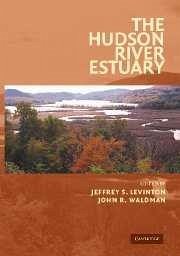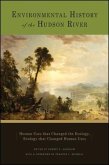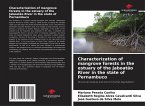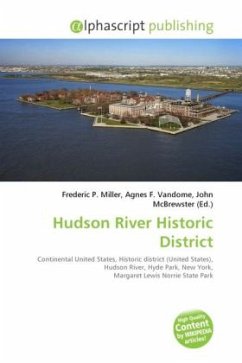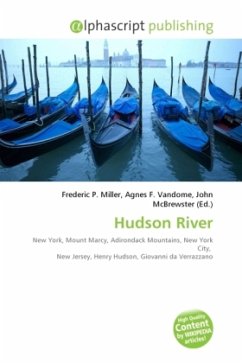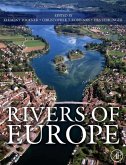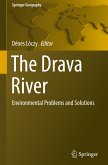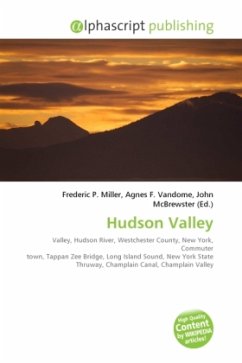Jeffrey S. Levinton / John R. Waldman (eds.)
The Hudson River Estuary
Herausgeber: Levinton, Jeffrey S; Waldman, John R
Jeffrey S. Levinton / John R. Waldman (eds.)
The Hudson River Estuary
Herausgeber: Levinton, Jeffrey S; Waldman, John R
- Gebundenes Buch
- Merkliste
- Auf die Merkliste
- Bewerten Bewerten
- Teilen
- Produkt teilen
- Produkterinnerung
- Produkterinnerung
The Hudson River Estuary is a 2006 scientific biography with relevance to similar natural systems.
Andere Kunden interessierten sich auch für
![Environmental History of the Hudson River: Human Uses That Changed the Ecology, Ecology That Changed Human Uses Environmental History of the Hudson River: Human Uses That Changed the Ecology, Ecology That Changed Human Uses]() Environmental History of the Hudson River: Human Uses That Changed the Ecology, Ecology That Changed Human Uses109,99 €
Environmental History of the Hudson River: Human Uses That Changed the Ecology, Ecology That Changed Human Uses109,99 €![Characterization of mangrove forests in the estuary of the Jaboatão River in the state of Pernambuco Characterization of mangrove forests in the estuary of the Jaboatão River in the state of Pernambuco]() Mariana Pessôa CoelhoCharacterization of mangrove forests in the estuary of the Jaboatão River in the state of Pernambuco28,99 €
Mariana Pessôa CoelhoCharacterization of mangrove forests in the estuary of the Jaboatão River in the state of Pernambuco28,99 €![Hudson River Historic District Hudson River Historic District]() Hudson River Historic District24,99 €
Hudson River Historic District24,99 €![Hudson River Hudson River]() Hudson River32,99 €
Hudson River32,99 €![Rivers of Europe Rivers of Europe]() Klement TocknerRivers of Europe252,99 €
Klement TocknerRivers of Europe252,99 €![The Drava River The Drava River]() The Drava River81,99 €
The Drava River81,99 €![Hudson Valley Hudson Valley]() Hudson Valley28,99 €
Hudson Valley28,99 €-
-
-
The Hudson River Estuary is a 2006 scientific biography with relevance to similar natural systems.
Hinweis: Dieser Artikel kann nur an eine deutsche Lieferadresse ausgeliefert werden.
Hinweis: Dieser Artikel kann nur an eine deutsche Lieferadresse ausgeliefert werden.
Produktdetails
- Produktdetails
- Verlag: Cambridge University Press
- Seitenzahl: 488
- Erscheinungstermin: 9. Januar 2006
- Englisch
- Abmessung: 262mm x 182mm x 28mm
- Gewicht: 1021g
- ISBN-13: 9780521844789
- ISBN-10: 0521844789
- Artikelnr.: 21573233
- Herstellerkennzeichnung
- Libri GmbH
- Europaallee 1
- 36244 Bad Hersfeld
- gpsr@libri.de
- Verlag: Cambridge University Press
- Seitenzahl: 488
- Erscheinungstermin: 9. Januar 2006
- Englisch
- Abmessung: 262mm x 182mm x 28mm
- Gewicht: 1021g
- ISBN-13: 9780521844789
- ISBN-10: 0521844789
- Artikelnr.: 21573233
- Herstellerkennzeichnung
- Libri GmbH
- Europaallee 1
- 36244 Bad Hersfeld
- gpsr@libri.de
Jeffrey Levinton is Professor of Ecology and Evolution at Stony Brook University and has worked for many years as a researcher in marine ecology and as a textbook writer in marine biology. He has been a Guggenheim Fellow, a Fulbright Senior Fellow and has done research and lectured at many institutions throughout the world. He is also the recipient of the State University of NY Chancellor's award for excellence in teaching.
John Waldman is Professor of Biology in the City University of New York. He is a well known fisheries scientist and is the author of a number of popular books in natural science. Before coming to Queens College of the City University of New York, he worked for 20 years as senior scientist of the Hudson River Foundation.
John Waldman is Professor of Biology in the City University of New York. He is a well known fisheries scientist and is the author of a number of popular books in natural science. Before coming to Queens College of the City University of New York, he worked for 20 years as senior scientist of the Hudson River Foundation.
1. The Hudson River Estuary: executive summary; Part I. Geological,
Physical and Chemical Setting of the Hudson: 2. The Hudson River Valley:
geological history, landforms and resources; 3. The Physical oceanography
processes of the Hudson River; 4. Sedimentary processes in the Hudson River
Estuary; 5. Benthic habitat mapping in the Hudson River Estuary; 6.
Reconstructing sediment chronologies in the Hudson River Estuary; 7. Major
ion geochemistry and drinking water supply issues in the Hudson River
Basin; Part II. Primary Production, Microbial Dynamics and Nutrient
Dynamics of the Hudson: 8. Bacterial abundance, growth and metabolism in
the tidal freshwater Hudson River; 9. Primary production and its regulation
in the tidal-freshwater Hudson River; 10. Wastewater and watershed
influences on primary productivity and oxygen dynamics in the lower Hudson
River Estuary; 11. Modeling primary production in the lower Hudson River
Estuary; Part III. Hudson River Communities, Food Webs and Fisheries: 12.
Larval migrations between the Hudson River Estuary and New York Bight; 13.
The diadromous fish fauna of the Hudson River: life histories, conservation
concerns, and research avenues; 14. Fisheries of the Hudson River Estuary;
15. The role of tributaries in the biology of Hudson River fishes; 16.
Ecology of the Hudson River zooplankton community; 17. Submerged macrophyte
distribution and function in the tidal freshwater Hudson River; 18.
Long-term and large-scale patterns in the benthic communities of New York
Harbor; 19. The benthic animal communities of the tidal-freshwater Hudson
River Estuary; 20. Tidal wetlands of the Hudson River 21. Alien species in
the Hudson River; Part IV. Contaminants and Management Issues of the Hudson
River Estuary: 22. The history and science of managing the Hudson River;
23. Hudson River sewage inputs and impacts: past and present; 24. PCBs in
the upper and tidal-freshwater Hudson River Estuary: The science behind the
dredging controversy; 25. Transport, fate and bioaccumulation of PCBs in
the lower Hudson River; 26. Contaminant chronologies from Hudson River
sedimentary records; 27. Atmospheric deposition of PCBs and PAHs to the New
York Harbor Estuary; 28. Toxic substances and their impacts on human health
in the Hudson River watershed; 29. Impacts of piers on juvenile fishes in
the lower Hudson River; 30. Toxic responses of Hudson River populations to
chemical contaminants.
Physical and Chemical Setting of the Hudson: 2. The Hudson River Valley:
geological history, landforms and resources; 3. The Physical oceanography
processes of the Hudson River; 4. Sedimentary processes in the Hudson River
Estuary; 5. Benthic habitat mapping in the Hudson River Estuary; 6.
Reconstructing sediment chronologies in the Hudson River Estuary; 7. Major
ion geochemistry and drinking water supply issues in the Hudson River
Basin; Part II. Primary Production, Microbial Dynamics and Nutrient
Dynamics of the Hudson: 8. Bacterial abundance, growth and metabolism in
the tidal freshwater Hudson River; 9. Primary production and its regulation
in the tidal-freshwater Hudson River; 10. Wastewater and watershed
influences on primary productivity and oxygen dynamics in the lower Hudson
River Estuary; 11. Modeling primary production in the lower Hudson River
Estuary; Part III. Hudson River Communities, Food Webs and Fisheries: 12.
Larval migrations between the Hudson River Estuary and New York Bight; 13.
The diadromous fish fauna of the Hudson River: life histories, conservation
concerns, and research avenues; 14. Fisheries of the Hudson River Estuary;
15. The role of tributaries in the biology of Hudson River fishes; 16.
Ecology of the Hudson River zooplankton community; 17. Submerged macrophyte
distribution and function in the tidal freshwater Hudson River; 18.
Long-term and large-scale patterns in the benthic communities of New York
Harbor; 19. The benthic animal communities of the tidal-freshwater Hudson
River Estuary; 20. Tidal wetlands of the Hudson River 21. Alien species in
the Hudson River; Part IV. Contaminants and Management Issues of the Hudson
River Estuary: 22. The history and science of managing the Hudson River;
23. Hudson River sewage inputs and impacts: past and present; 24. PCBs in
the upper and tidal-freshwater Hudson River Estuary: The science behind the
dredging controversy; 25. Transport, fate and bioaccumulation of PCBs in
the lower Hudson River; 26. Contaminant chronologies from Hudson River
sedimentary records; 27. Atmospheric deposition of PCBs and PAHs to the New
York Harbor Estuary; 28. Toxic substances and their impacts on human health
in the Hudson River watershed; 29. Impacts of piers on juvenile fishes in
the lower Hudson River; 30. Toxic responses of Hudson River populations to
chemical contaminants.
1. The Hudson River Estuary: executive summary; Part I. Geological,
Physical and Chemical Setting of the Hudson: 2. The Hudson River Valley:
geological history, landforms and resources; 3. The Physical oceanography
processes of the Hudson River; 4. Sedimentary processes in the Hudson River
Estuary; 5. Benthic habitat mapping in the Hudson River Estuary; 6.
Reconstructing sediment chronologies in the Hudson River Estuary; 7. Major
ion geochemistry and drinking water supply issues in the Hudson River
Basin; Part II. Primary Production, Microbial Dynamics and Nutrient
Dynamics of the Hudson: 8. Bacterial abundance, growth and metabolism in
the tidal freshwater Hudson River; 9. Primary production and its regulation
in the tidal-freshwater Hudson River; 10. Wastewater and watershed
influences on primary productivity and oxygen dynamics in the lower Hudson
River Estuary; 11. Modeling primary production in the lower Hudson River
Estuary; Part III. Hudson River Communities, Food Webs and Fisheries: 12.
Larval migrations between the Hudson River Estuary and New York Bight; 13.
The diadromous fish fauna of the Hudson River: life histories, conservation
concerns, and research avenues; 14. Fisheries of the Hudson River Estuary;
15. The role of tributaries in the biology of Hudson River fishes; 16.
Ecology of the Hudson River zooplankton community; 17. Submerged macrophyte
distribution and function in the tidal freshwater Hudson River; 18.
Long-term and large-scale patterns in the benthic communities of New York
Harbor; 19. The benthic animal communities of the tidal-freshwater Hudson
River Estuary; 20. Tidal wetlands of the Hudson River 21. Alien species in
the Hudson River; Part IV. Contaminants and Management Issues of the Hudson
River Estuary: 22. The history and science of managing the Hudson River;
23. Hudson River sewage inputs and impacts: past and present; 24. PCBs in
the upper and tidal-freshwater Hudson River Estuary: The science behind the
dredging controversy; 25. Transport, fate and bioaccumulation of PCBs in
the lower Hudson River; 26. Contaminant chronologies from Hudson River
sedimentary records; 27. Atmospheric deposition of PCBs and PAHs to the New
York Harbor Estuary; 28. Toxic substances and their impacts on human health
in the Hudson River watershed; 29. Impacts of piers on juvenile fishes in
the lower Hudson River; 30. Toxic responses of Hudson River populations to
chemical contaminants.
Physical and Chemical Setting of the Hudson: 2. The Hudson River Valley:
geological history, landforms and resources; 3. The Physical oceanography
processes of the Hudson River; 4. Sedimentary processes in the Hudson River
Estuary; 5. Benthic habitat mapping in the Hudson River Estuary; 6.
Reconstructing sediment chronologies in the Hudson River Estuary; 7. Major
ion geochemistry and drinking water supply issues in the Hudson River
Basin; Part II. Primary Production, Microbial Dynamics and Nutrient
Dynamics of the Hudson: 8. Bacterial abundance, growth and metabolism in
the tidal freshwater Hudson River; 9. Primary production and its regulation
in the tidal-freshwater Hudson River; 10. Wastewater and watershed
influences on primary productivity and oxygen dynamics in the lower Hudson
River Estuary; 11. Modeling primary production in the lower Hudson River
Estuary; Part III. Hudson River Communities, Food Webs and Fisheries: 12.
Larval migrations between the Hudson River Estuary and New York Bight; 13.
The diadromous fish fauna of the Hudson River: life histories, conservation
concerns, and research avenues; 14. Fisheries of the Hudson River Estuary;
15. The role of tributaries in the biology of Hudson River fishes; 16.
Ecology of the Hudson River zooplankton community; 17. Submerged macrophyte
distribution and function in the tidal freshwater Hudson River; 18.
Long-term and large-scale patterns in the benthic communities of New York
Harbor; 19. The benthic animal communities of the tidal-freshwater Hudson
River Estuary; 20. Tidal wetlands of the Hudson River 21. Alien species in
the Hudson River; Part IV. Contaminants and Management Issues of the Hudson
River Estuary: 22. The history and science of managing the Hudson River;
23. Hudson River sewage inputs and impacts: past and present; 24. PCBs in
the upper and tidal-freshwater Hudson River Estuary: The science behind the
dredging controversy; 25. Transport, fate and bioaccumulation of PCBs in
the lower Hudson River; 26. Contaminant chronologies from Hudson River
sedimentary records; 27. Atmospheric deposition of PCBs and PAHs to the New
York Harbor Estuary; 28. Toxic substances and their impacts on human health
in the Hudson River watershed; 29. Impacts of piers on juvenile fishes in
the lower Hudson River; 30. Toxic responses of Hudson River populations to
chemical contaminants.

